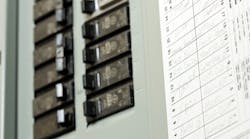Code updates happen for one main reason: safety improvement. National Electrical Code (NEC) Sec. 408.3 helps take electrical safety for service entrance panels to a new level. The 2017 NEC includes provisions to provide shock protection via panelboard barriers. The barriers protect from energized conductors on the line terminals of the main overcurrent protection device (OCPD) in a panelboard. When the main circuit breaker in a panel is turned off, line side terminals and conductors remain energized from upstream via the electric utility or another panelboard. With these barriers in place and the main OCPD turned off, installers are better protected when pulling wires into the panelboard. Today, all panelboards are shipped with shock-protective barriers. However, barriers are new to installation procedures, so contractors may not recognize them and accidentally throw them out — easily and often.
Change and Compromise
The 2014 and 2017 Code review cycles included public input for barriers on the line side of the main OCPD of a service entrance panelboard. In 2014, the NEC established rules whereby every panelboard (residential or otherwise) must feature a complete top-of-the-panel barrier. In 2017, they reached a compromise for a new requirement: protective coverings and barriers must protect exposed energized lugs and conductors, but only on the line side of the main OCPD in service entrance panelboards. With these coverings in place, conductors are still permitted to be pulled through the top of the panel past the fingersafe protective coverings of those energized lugs.
The Importance of Panelboard Barriers
Imagine adding a circuit to a home. The contractor would first shut off the main breaker and then push new wire through the top of the panelboard. Without the barrier along the line side terminals, the additional wiring would pass right by exposed 240V because the house feed would likely still be active (or energized). But with a barrier in place, the possibility of contact with the lugs on the line side of the panelboard is reduced, which helps to greatly increase safety.
I don’t hear a lot of contractor pushback on this new requirement, which makes sense; shock-protective barriers ship with all panelboards and are easy to install. Unfortunately, many contractors simply forget about them! Inspectors are well-versed in the new Code; once a contractor has everything installed and the lugs torqued, an inspector will be sure to look for the barriers. If they haven’t been implemented, the contractor will have to take everything apart and might need to involve the electric utility to cut the power if the panelboard is energized.
Frequent Barrier Use Can Mean Safer Work Environments
While there’s nothing scarier than pushing a wire through a panelboard and staring at an exposed energized lug, it’s a risk some contractors take to save time. Calling the electric utility to disconnect the service when adding a branch circuit to a receptacle is often viewed as overkill, especially when shutting the main off has been acceptable for years. This begs the question, “Why not protect all line side main breaker lugs with these barriers above and beyond Code?” In addition to being easy to install and cost-effective, doing so adds an increased layer of protection.
Pros across the industry can use barriers beyond service entrance panels. Remember, the NEC offers minimum requirements. But why hold safety to a minimum? Think about it like this: If you and I were to go skydiving, and I gave you a choice to buy a parachute that’s built to a minimum requirement and another including safety equipment that far exceeds the minimum requirement, I’m guessing you wouldn’t hesitate to choose the one with the higher safety rating.
Stay Safe: Remember the Barriers, and Use Them Often
When aligning with the new requirements of Sec. 408.3, be sure to implement barriers whenever installing a new panelboard. Forgetting them could seriously impact your safety. Barriers are easy to install and cost-effective. I strongly suggest that contractors go beyond the code by using barriers wherever applicable to provide increased levels of protection.
Domitrovich, P.E., is vice president, technical sales at Eaton, St. Louis, Mo. He can be reached at [email protected].



